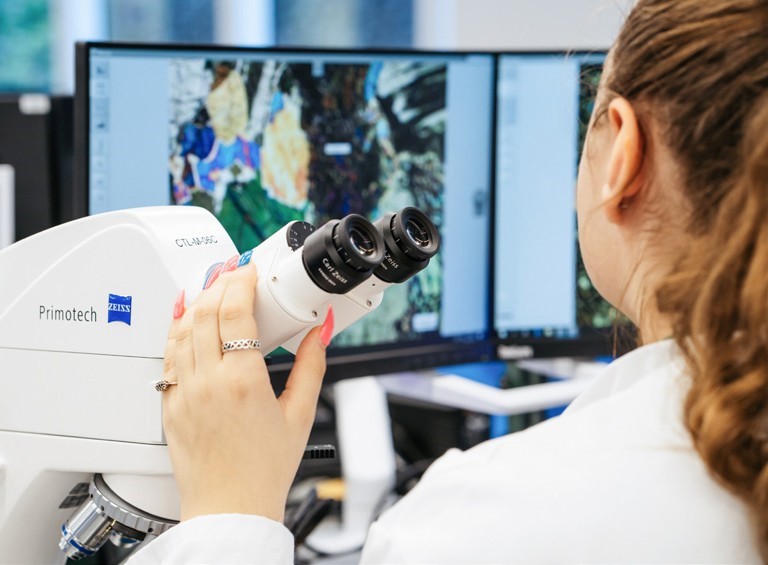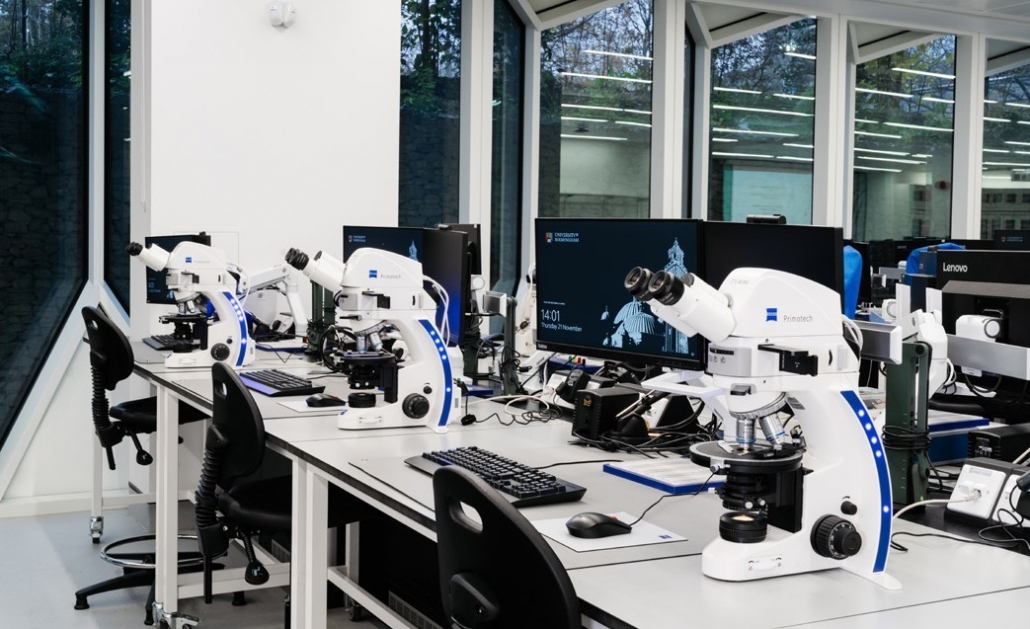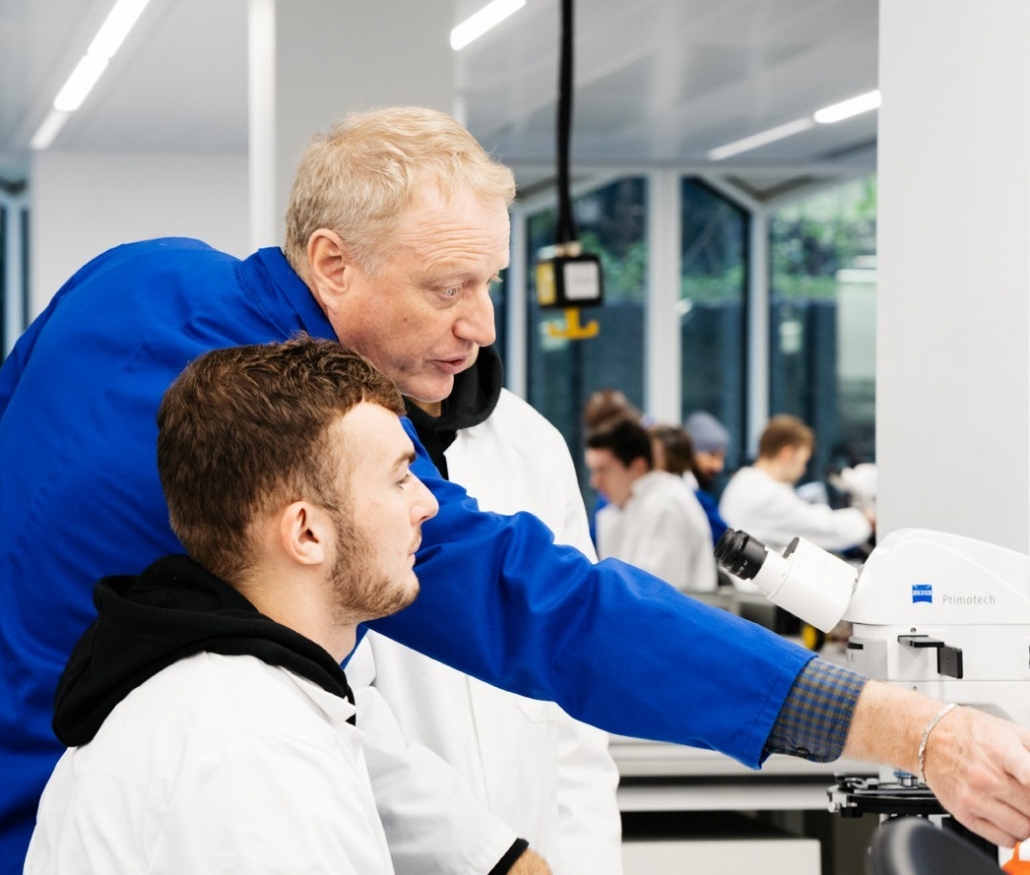University of Birmingham invests in largest ZEISS Digital Classroom in Europe

176 state-of-the-art ZEISS microscopes are partnered with the award winning Labscope teaching software
The University of Birmingham cemented its position as a pioneer of cutting-edge education in 2018 with the creation of the largest digital microscope classroom in Europe. The ZEISS Digital Classroom suite is part of the university’s Collaborative Teaching Laboratory (CTL) and boasts a networked set of 176 ZEISS microscopes – a combination of the ZEISS Primotech and Stemi 305 models. These state-of-the-art microscopes, in combination with the award-winning Labscope teaching software, have transformed how teaching is done at Birmingham and raised the bar on what teachers and students can achieve together in the lab.
Transforming the Student Experience
We talked to three members of the CTL’s teaching staff for this case study, and the first thing we learned is that the ZEISS microscopes, with their intuitive design and high-definition built-in cameras, have radically transformed the student experience and boosted engagement. “The ZEISS Digital Classroom has profoundly changed the way we teach,” says Mrs Aruna Mistry, Dry Lab Manager for the CTL, who managed the microscope procurement process. “It’s the sheer interactivity of it that has changed everything: all the students can have an individual image on their device, and we teachers can pick up those images and instantly share them on the big screens. Alternatively, the lecturer can display whatever they are looking at on their teaching microscope on the students’ personal screens.”
In addition to looking through the microscope, students also use networked PCs to explore their slides, while the ZEISS Labscope. software enables them to take high-resolution photos and videos of their samples, make accurate measurements, and much more. Students have embraced the system, says Mistry. “They like the idea of everything being at their fingertips. The optics are so good, sometimes they just want to come in to look at their thin sections. And being able to take an image if they want to, straight away, because it is all connected… they just love it.”

Maximising teaching time
The state-of-the art ZEISS units are sleek, intuitive and “student- proof”, says Mistry: “In practical classes or exams, I can just take the dust cover off and it is ready to go. This changed my life. Before the ZEISS installation, I’d have to give the equipment a quick service before we could start.”
Dr Alan Hastie, who teaches petrology and geochemistry at the university, is equally enthusiastic about how the linked microscopes of the ZEISS Digital Classroom maximise teaching time: “With the digital set up, with one click on one screen I can tell if 70 students have their microscopes set up correctly. I no longer have to check everyone individually, which can take an age.” Not only is time saved – teaching is accelerated. “I can pull images from individual students’ microscopes and instantly share them with the class to demonstrate very good examples to the other students. It makes teaching a lot easier and more streamlined.”
Boosting Exam Results
It not only feels like it is working better. The proof is in the pudding. “The ZEISS equipment allowed me to get my students to a satisfactory level faster than I could in previous years. And this was borne out by exam results,” says Hastie. This accelerated teaching is facilitated by ZEISS’s Labscope Teacher software, which puts the lecturer in charge of all the microscopes in the network while they move freely around the lab. Labscope Teacher also lets the lecturer define working groups, set group-specific tasks and implement all sorts of teamwork-boosting practices.
Digital Documentation and Feedback
No one on the teaching staff in the new CTL is yearning for the old days. Dr James Wheeley, a senior lecturer in sedimentary geology, remembers them all too well. “Before, we used very traditional microscope set ups, where students had to draw what they looked at. One of our top priorities for this new system was the capability to instantly capture, in high resolution, what the students were looking at, so that they could work with these images after the lab and use them for presentations. That was really important to us.”
The ZEISS Digital Classroom ecosystem also gives faculty the flexibility to feed back to students electronically on things they have imaged through the system. “We’ve been able to teach students how to properly present microscope images and annotate them up afterwards in software, which was difficult to do previously,” says Wheeley.
Preparing students for industry

Having students learn these modern working practices feeds into a central motivation for equipping the CTL with ZEISS systems in the first place. “The idea behind the CTL was that we are preparing our students for industry; that they acquire the skills they need here, so that when they start their careers they won’t need retraining,” says Mistry. “We wanted the equipment to be state-of-the-art, the lab to be state-of-the-art, the staff to be fully trained into what they are delivering. Buying the right type of microscopes was crucial.”
Wheeley agrees: “Everything the students are working with now is digital. This system allows them to present work to a professional standard, which is what will be required of them in their first jobs after university.”
Being one of the most advanced teaching labs in Europe, and indeed the world, inevitably makes the University of Birmingham particularly attractive to new students. Though, admittedly, this gold-standard status is not always fully appreciated. “Sometimes, new first-year students don’t realise quite how good they have it,” says Hastie. “At other universities, the equipment is – how do I put this diplomatically? – a wee bit antiquated. Our students come in fresh and get to use this fantastic equipment straight off. This is their normal. I’m in the privileged position to know that they have it very good indeed!”
The ZEISS Digital Classroom was part of a £45 million investment at the University of Birmingham, so naturally multiple suppliers were consulted. What was it that won over Mistry and her many colleagues? “The decision to buy took nearly two years and we really explored our options – we had workshops and demonstrations with many potential suppliers,” says Mistry. “Ultimately, the ZEISS system is the only one that could deliver what we said we wanted – we couldn’t ask for more. And the ongoing support from ZEISS has been brilliant. Anything we asked, anything we needed, they were there.”
To learn more about the ZEISS Digital Classroom, visit: www.zeiss.ly/digitalclassrooms

